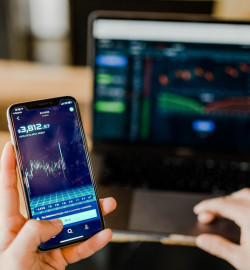What is Digital Marketing: Definition, Examples, Solutions for Business
The internet has changed the way we do marketing. Earlier, you needed to go an extra mile (literally) to advertise your business—publish an ad in a newspaper, pay an agency to put your business on billboards, and break the bank to squeeze into airtime on TV.
Today, you don’t even have to leave your office or home to promote your product. And, video ads on YouTube cost much less than TV advertisements (and bring you more engagement).
That being said, the scope of internet marketing is constantly changing—it’s not the same as it was several years ago, with all the digital technologies evolving and Google introducing new changes to the algorithm.
So, how has the definition of online marketing changed? What does it mean in 2022, and what is the future of digital marketing?
Let’s answer these and some other questions to help you better understand the theory behind internet marketing.
What is Digital Marketing?
Digital marketing utilizes digital technologies, the internet, and its channels to connect with consumers and promote a product or service.
From this definition, you can assume that this form of marketing primarily focuses on online strategies, but it’s not entirely so. Some offline promotional techniques, such as radio and TV marketing, can be attributed to offline digital marketing since they use electronic devices but don’t need an Internet connection.
Digital marketing vs. online marketing and internet marketing
You might have noticed these terms circling the internet. But is there any difference between them? Let’s take a look at the definitions.
Digital marketing is a broader term for all strategies that involve electronic devices to advertise a product or service. And, as we’ve figured out, it includes both online and offline means.
In its turn, online marketing, also known as internet marketing, only focuses on online strategies of connecting with an audience.
In other words, you can say that online/internet marketing is a part of digital marketing.
Digital marketing vs. traditional marketing
On the surface, the difference between digital marketing and traditional marketing is obvious. However, as we figured, radio advertising, which is generally deemed a part of traditional marketing, is now considered a part of digital strategies.
So, what makes these two areas of marketing different?
The answer is in the medium both of them use. Digital marketing relies on devices and the Internet to promote products and services, while traditional marketing uses newspapers, magazines, and other traditional media.
In practice, both strategies can coexist and overlap. For instance, if an ad is posted in print media, it’s a part of traditional marketing. However, if it’s an online version of a magazine or newspaper, we’re talking about digital marketing.
Areas of digital marketing
As a discipline, digital marketing includes ten key areas. Let’s explore each of them individually.
1) Content marketing
Content marketing is an area of digital marketing that focuses on creating and distributing content targeting a specific audience.
Content marketing today is one of the pillars of successful online branding. It serves as a medium connecting a business with its audience through a shared interest and proposed value.
2) Social media marketing
Social media marketing is a part of online marketing that uses social media platforms to reach out to customers and promote a product or service. Today, it’s close to impossible to get your brand noticed without social media. And you can see why – these platforms have enormous audiences. Facebook alone unites 2.89 billion people, and its users are so diverse that any business can successfully advertise there.
3) Search engine optimization (SEO)
Searching engine optimization is a set of strategies to improve the quantity and quality of traffic driven from search engines to your website or web page.
It’s hard to imagine online digital marketing without SEO in 2022—it is involved in creating content, landing pages and even has a connection with social media marketing. The goal is to improve your rankings in organic search that currently dominates the digital world.
4) Search engine marketing (SEM)
Search engine marketing is a strategy that uses promotional methods, such as paid advertising, to increase a website’s visibility in search results.
There is a distinct difference between SEM and SEO. If you want to promote your website using SEO, you’ll be focusing solely on organic traffic. Conversely, SEM involves both organic and paid search to get traffic to a website, thus, giving you more opportunities to rank higher.
5) Brand management
Brand management is a group of strategies that help determine the brand’s current position in the market and what needs to be done to improve its perceived value.
From this definition, you can tell right away that brand management is not just about online digital marketing. It can involve offline strategies and PR. But the goal is to align the brand’s image with its objectives.
6) Mobile marketing
Mobile marketing is an area of online marketing that involves strategies to help a business connect with its audience via mobile devices.
The role of mobile marketing is growing, which requires businesses to become more mobile-friendly. If you invest in a more responsive website, it positively impacts your reach and helps you rank higher in Google.
7) Digital PR
Digital PR is a strategy that involves online channels to promote a brand. It is also connected to other digital marketing strategies mentioned above, such as content marketing, influencer marketing, social media, and SEO.
Digital PR involves the following tactics:
- online press releases
- influencer outreach
- online business profiling
- organizing online interviews
- publishing content on popular online resources
Since digital marketing focuses on selling and brand awareness, digital PR offers relevant strategies to increase a brand’s visibility online.
8) Campaign management
Campaign management is an area of digital marketing that includes tactics to plan, execute, track, and analyze a marketing campaign.
The goal of campaign management is to optimize all marketing efforts across multiple channels. Your task is to align every promotional strategy with your audience’s pain points.
9) Web analytics
Web analytics is an area in online digital marketing that involves collecting, measuring, analyzing, and tracking web data and using it to optimize online marketing efforts.
One of the aspects that web analytics helps marketers cover is consumer behaviors and purchase patterns. Having this data at hand can help you optimize almost every marketing strategy, from paid ads to blog content.
10) Competitor tracking
Competitor tracking is a strategy that helps a brand collect competitor data and later use it to improve a marketing strategy or campaign.
Competitor analysis has a set of benefits:
- helps develop a unique sales proposition
- supplies you with helpful marketing data
- helps you spot gaps in your marketing strategies
You can also use competitor tracking to improve your product or service and better understand the market.
The role of digital marketing today
Digital marketing has become a buzzword over the past few years. And, to back up this statement, here’s a graph from Google Trends depicting the growth of this term’s popularity from 2015 to 2022:
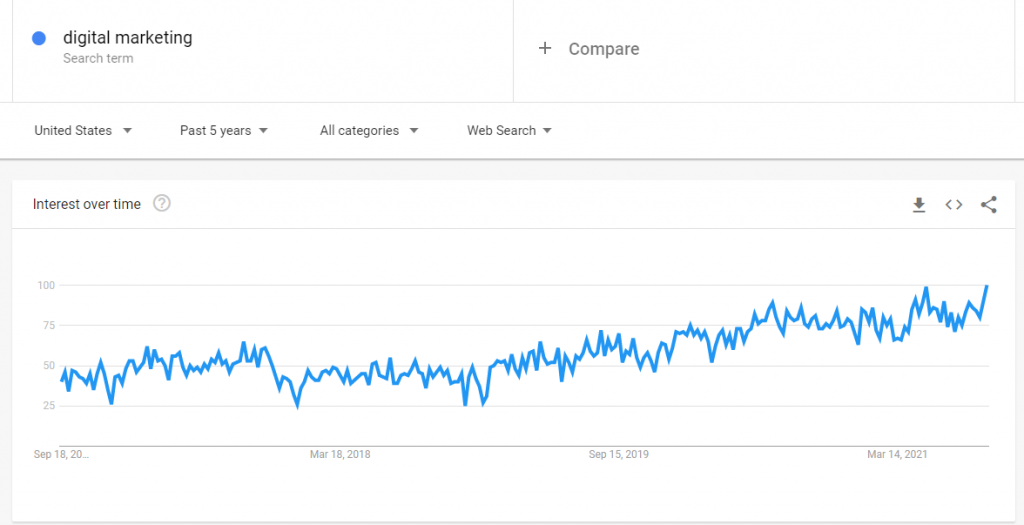
The role of online digital marketing has been growing along with the talks surrounding this topic. But what are its tasks in promoting business online?
Here are just a few examples:
- It helps you set a direction to get your business recognized online.
- You get to find the right target audience and build stronger relationships with your buyers.
- Online marketing offers methods to analyze the market and help you outrank your competitors.
- Your business can form a clear and unique value proposition taking into account the characteristic traits of your brand.
- You get ongoing growth opportunities.
Let’s sum up.
The role of digital marketing is to help you advance your online presence by boosting traffic, promoting your product or service to generate online leads, and turn them into loyal customers.
But keep in mind – the nature and the role of web marketing is constantly changing, which means you should remain well-informed about the ever-changing scope of this marketing field.
When is digital marketing day celebrated?
Digital marketing day is celebrated on the 16th of December. It is the day to build awareness and promote the current and upcoming trends in digital marketing.
You will find many companies schedule conferences and webinars on this day. It is also a great idea to add this day to your content calendar and spread the word with some engaging posts.
Industries that Need Digital Marketing
A rookie in online marketing might think it’s primarily useful for SaaS and e-commerce businesses, but it’s not. The impact of web marketing spreads to many other industries (if not all industries you can possibly come across). Let’s take a look at some examples.
1) Food
Food is an inalienable part of our daily life; it’s our fuel. That’s why the food industry will never stop growing and bringing along new trends which consumers need to know to fulfill their basic needs.
Besides, content involving food is super interesting to binge on: food channels on YouTube, for instance, get a 280% growth in subscriptions year over year. Food-related content is not just entertaining; it’s also highly informative – you can learn how to cook just by subscribing to Bon Appetit.
So, if you’re running a restaurant or a catering business, digital marketing is a must if you want to get noticed. You can be as creative as you want with your online marketing strategy. The key point is to give way to your brand’s unique nature.
Take HelloFresh as an example. The idea behind this meal kit company was to help people diversify their daily menus and promote home cooking. That’s why the company came up with an interactive Flavor Generator – you pick the cuisine and the flavors you like, and the tool generates a recipe idea:

The goal is to make your daily menu exciting and full of flavor. Such content is undoubtedly a win for HelloFresh since it carries a unique value for the consumers.
2) Health
Another front-rank industry that can benefit from online marketing is healthcare. The COVID-19 pandemic has changed how we look at healthcare services and revealed a need for more credible information online. Healthcare institutions and ventures can also use web marketing to become more accessible.
Thriva is an excellent example of a healthcare startup using digital marketing to grow. It sends you a blood test kit that you can safely use in the comfort of your home. To help the patients figure out what kind of test to order, Thriva has put together a comprehensive quiz:

This quiz is a part of Thriva’s content marketing strategy that helps personalize its services and makes the brand more trustworthy.
Apart from offering a service that caters to a patient’s needs, Thriva has a rich content strategy on Instagram to make people more aware of various health conditions and how to treat them. The brand also has a podcast, where doctors share helpful healthcare tips:
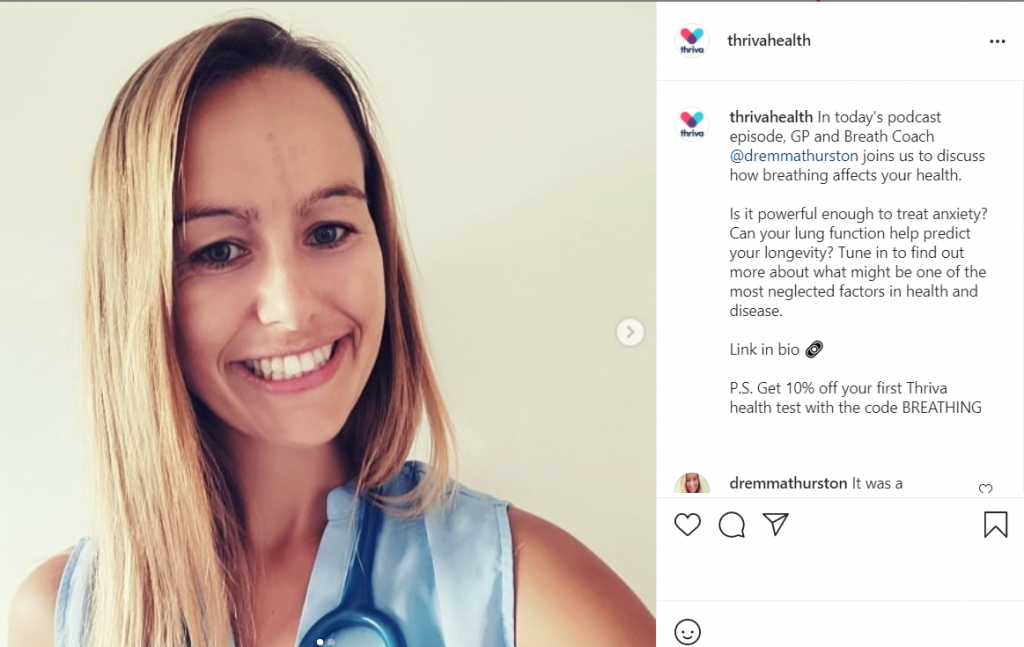
Thriva proves that it is possible to do digital marketing in industries with particular and narrow-focus audiences.
3) Education
Along with healthcare, education is another industry that had to rely on web marketing to stay afloat. The pandemic has facilitated online learning giving life to many education companies. The competition is growing fast as well.
Startups and companies in the education industry can spread the word about the current trends and changes through digital marketing. For instance, Coursera, an online learning platform, regularly promotes the hottest skills to encourage people to take a course:
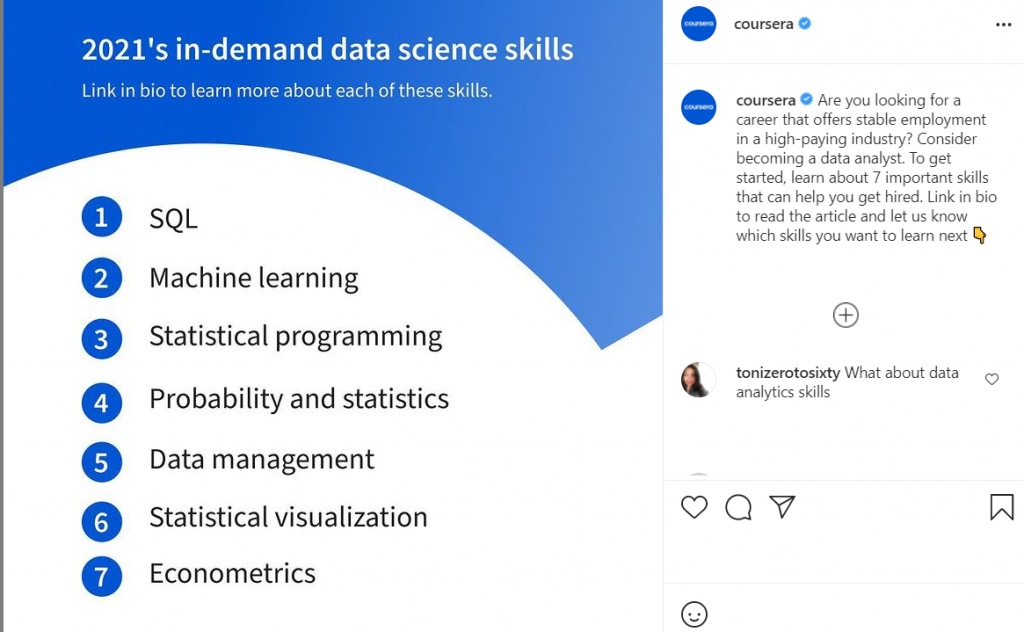
The brand also incorporates user-generated content as proof that online education is as effective as offline classes:

Coursera also runs a blog, where it uploads posts about its most recent partnerships, new courses, and news from the realm of online learning.
4) Manufacturing
It might seem that manufacturing companies wouldn’t benefit much from digital marketing, but it’s not true. Online marketing helps these businesses find new partnerships, tell more about their product, and educate their audience. It’s also your chance as a manufacturer to show behind-the-scenes of making your product.
Take Toyota, for example. Although its Instagram strategy primarily consists of car images, it posts the videos of car manufacturing process once in a while:

How can such an approach to digital marketing be helpful for a consumer?
Toyota understands that it’s every buyer’s interest to understand what goes into the process of creating a car. The video shows how the company approaches this process, what the environment is, and which technology is involved. All of it lifts a curtain for a customer a little bit and brings a brand and a buyer closer together, building trust.
5) Entertainment
Entertainment is one of our essential needs. Even though it’s not necessary for survival, it helps some of us unwind after a long day at work, while others use it to rest and recharge their brain. We will always be looking for opportunities to entertain ourselves.
That’s why digital marketing matters a lot for the entertainment industry. It helps create a strategy that would guide consumers to entertainment services, but the main focus is on making each offer personalized. Netflix solves this problem by collecting user data, analyzing behaviors, and generating emails with customized offers:
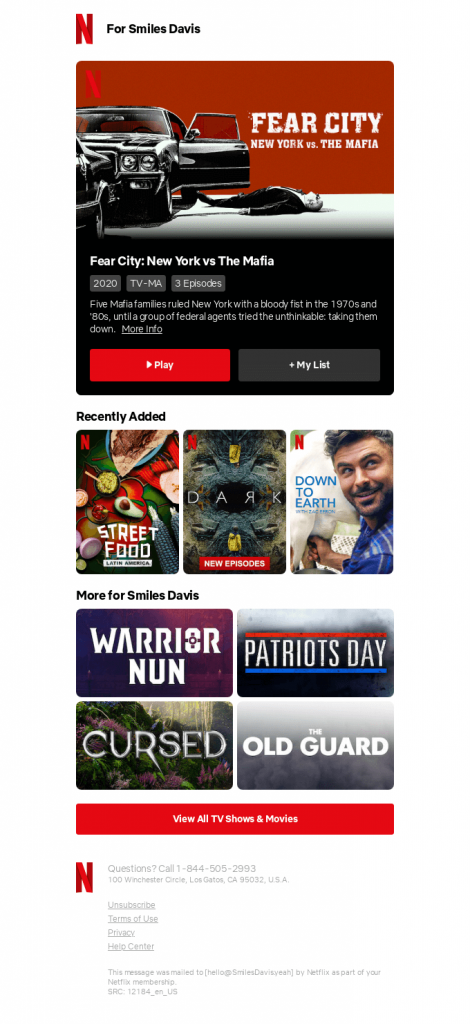
In general, a data-based approach to online marketing is gaining momentum across all industries, not just entertainment. It helps companies become more aware of the customer’s needs.
6) Real estate
Real estate is also one of the industries that have previously relied primarily on word-of-mouth recommendations. However, in the age of internet marketing, real estate agents can easily reach out to potential buyers via online channels, such as social media.
It has also become possible for real estate agents to do digital marketing for a website to grow their visibility and authority online. Ryan Serhant is an excellent example – his website contains a personal blog, courses, books, and helpful guides that can be of utmost value to future homeowners. All the real estate listings Ryan’s agency SERHANT has transferred to Instagram, where it’s easier for people to review properties:

As you can see, digital marketing makes it easy for real estate businesses to gain visibility. It offers a wide variety of channels to connect with prospects and promote the hottest real estate on the market.
7) Law
Law firms that previously mainly relied on word-of-mouth and advertisements have also tapped into the world of online marketing. Many of them run websites and blogs, while others use search ads to get more clients.
Some firms are implementing digital marketing in their business with the help of social media and LinkedIn, in particular. DLA Piper, a global law firm, uses this platform to share the recent news and updates in legislation:
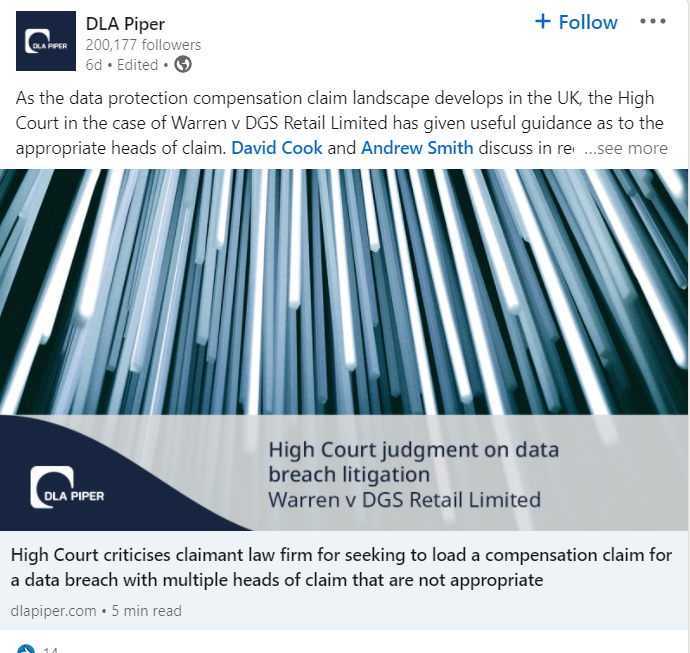
Online marketing offers lawyers many opportunities to grow and showcase their authority in the industry, which is essential for every law firm’s visibility.
8) Tourism
There are many ways the tourism industry can take advantage of digital marketing. A travel agency can start a blog sharing hotel recommendations and travel tips or create landing pages for every destination. And, of course, there’s Instagram and other social media, where you can advertise the hottest tours.
Tripadvisor took a step further and incorporated location reviews for every hotel, restaurant, and other business-related to the tourism industry:

This idea came from the fact that most travelers rely on recommendations and reviews before organizing a tour. It’s a perfect example of why it is important to understand how your industry operates before you get into digital marketing.
9) SaaS
Since we mentioned SaaS businesses as the most active digital marketing users, let’s consider the benefits they can get from growing an online presence:
- online demos
- webinars and other online events to educate prospects about a product
- a more diverse audience
- more channels to reach out to buyers
- multiple ways to advertise a product/service
As you can see, SaaS companies can use the same opportunities as other businesses to increase visibility. Additionally, to grow authority, a SaaS brand can launch online tutorials. Ahrefs is a fantastic example of this approach, using YouTube as a platform to educate its audience about all things SEO:
Digital marketing allows SaaS businesses to become more active, helpful and show their product and its features in action.
10) E-commerce
E-commerce thrives on digital marketing. There are no limitations as to the strategies an online shop can employ to promote its products online.
Most e-commerce businesses use retargeting and Google ads to advertise products to consumers. Here’s an example of an advertisement from Reserved powered by Google:

Essentially, these ads follow you around to remind you of the products that you reviewed and possibly liked. Displaying these products from time to time is a way of reminding you to go back to the shop and give the products a second chance.
Some e-commerce businesses start implementing digital marketing in their business by pairing their website and social media. For instance, Skims uses shoppable links on Instagram to redirect users to the product pages on the website:

You can also take advantage of social media ads, create videos for a YouTube channel, and even run a blog to build awareness around your products.
7 Examples of a Successful Digital Marketing Strategy
We’ve already briefly covered a few brands to give some context on how different industries can benefit from digital marketing.
Now, let’s take a look at a few specific online marketing strategy examples from brands and discuss the lessons we can learn from them.
1) Airbnb and user-generated content
Airbnb is doing a wide range of campaigns, from influencer marketing to targeted ads. However, its most prominent strategy is user-generated content featured across multiple marketing channels.
Take Airbnb’s website, for example. If you check out the Become a Host page, it is filled with pictures of people who already sublet their homes to Airbnb users. You can also read reviews from the hosts:

The next stop is Airbnb’s Instagram page, where it often features images and videos of hosts and the places they rent out:
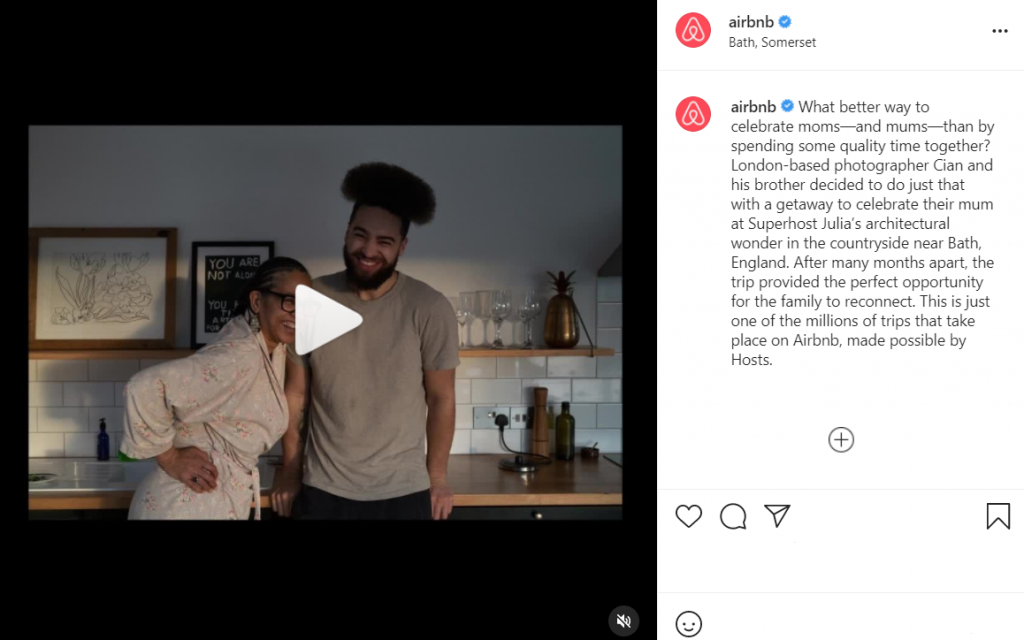
The company applies the same strategy to its Airbnb Experience Instagram page.
Why does Airbnb bet on user-generated content?
Over the past few years, more and more brands recognize the value of user-generated content and the set of perks it carries:
- more brand awareness and recognition
- access to unique audience data
- better ranking thanks to the original content
- valuable insights about product optimization
- higher personalization
User-generated content is valuable because it carries social proof. People use it to learn about a product before buying it. The graph by Statista also confirms it, showing that customer reviews are among the top sources people use to find out about new products:
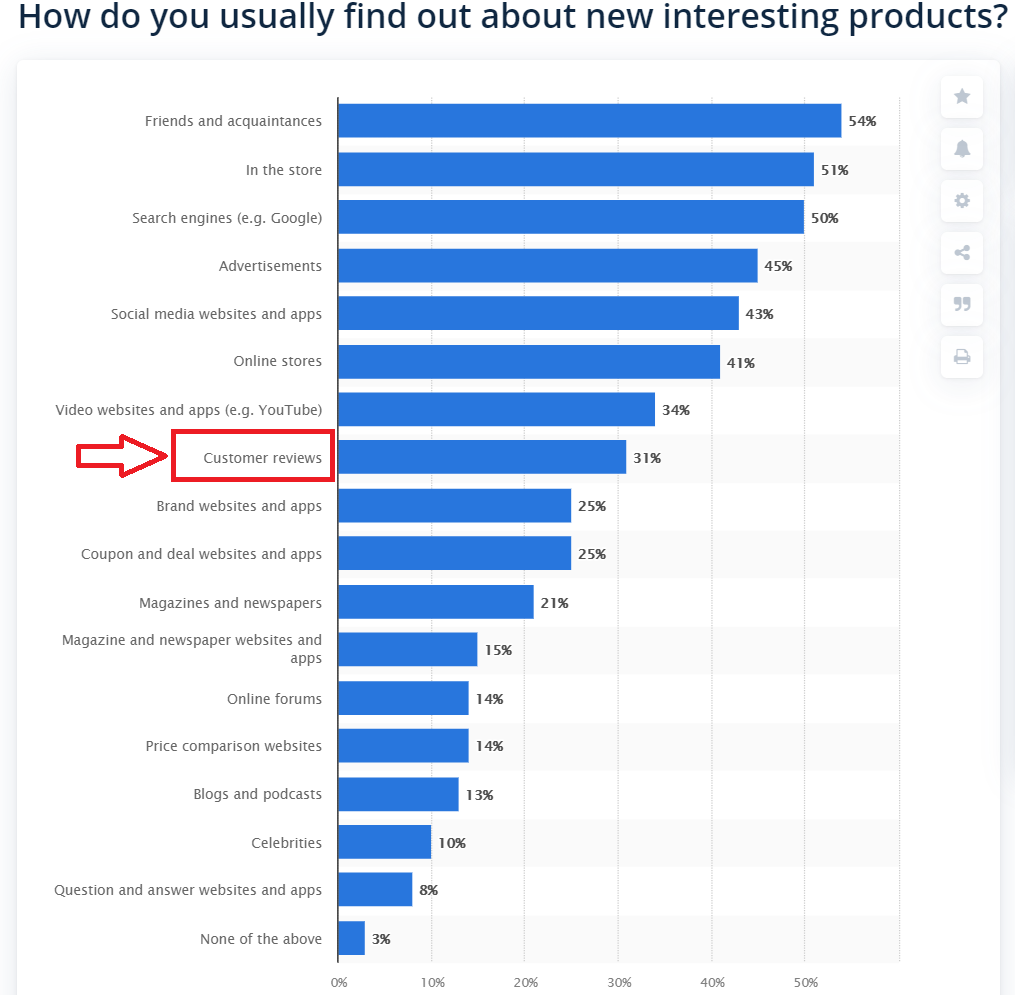
You can also think of friends and acquaintances, social media, and online forums as channels providing user-generated content to an extent since they share customer reviews and spread brand awareness.
2) Tidio and well-optimized landing pages
A landing page is a factor that forms and impacts brand identity. Its task is to follow up with the potential client on the promises you’ve made in your ads, blog content, and social media posts. A landing page is your chance to introduce your product to a buyer officially.
That being said, it’s not that easy to create an engaging landing page, which is also informative at the same time. Some brands make a mistake by focusing too much on text and product descriptions, while others overstuff their product pages with visuals.
Your goal is to find a golden middle between engagement and informational value.
Tidio managed to achieve that with its chatbot and live chat landing pages. First and foremost, they demonstrate the product, which both showcases its main features and saves up space, making the page look tidy:
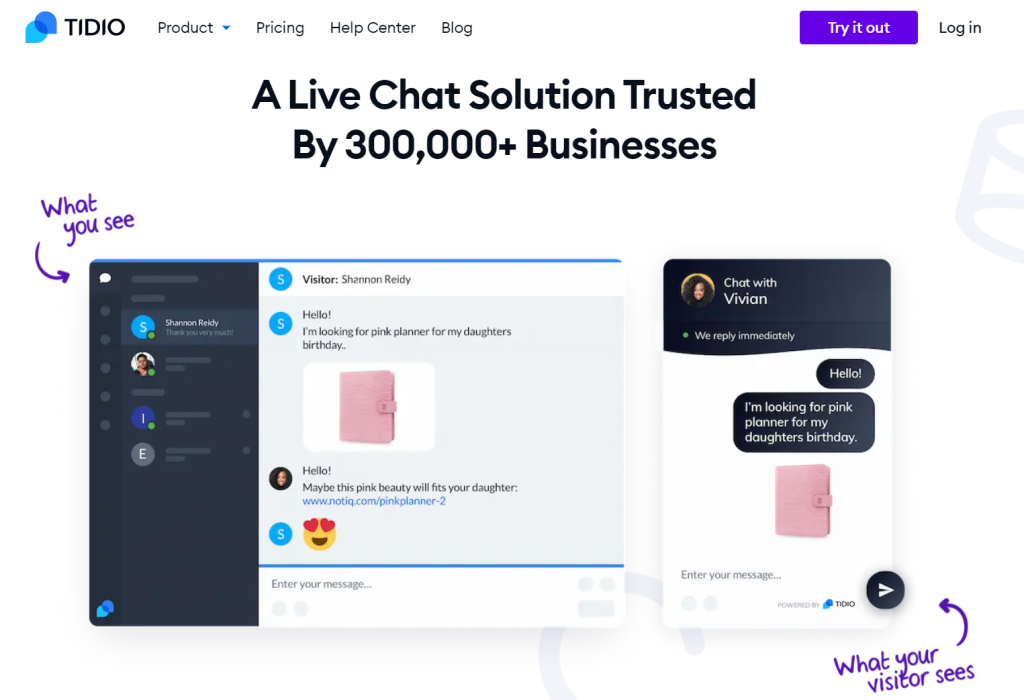
The company also blends customer reviews and a few compelling statistics into the landing pages to prove the product’s value:
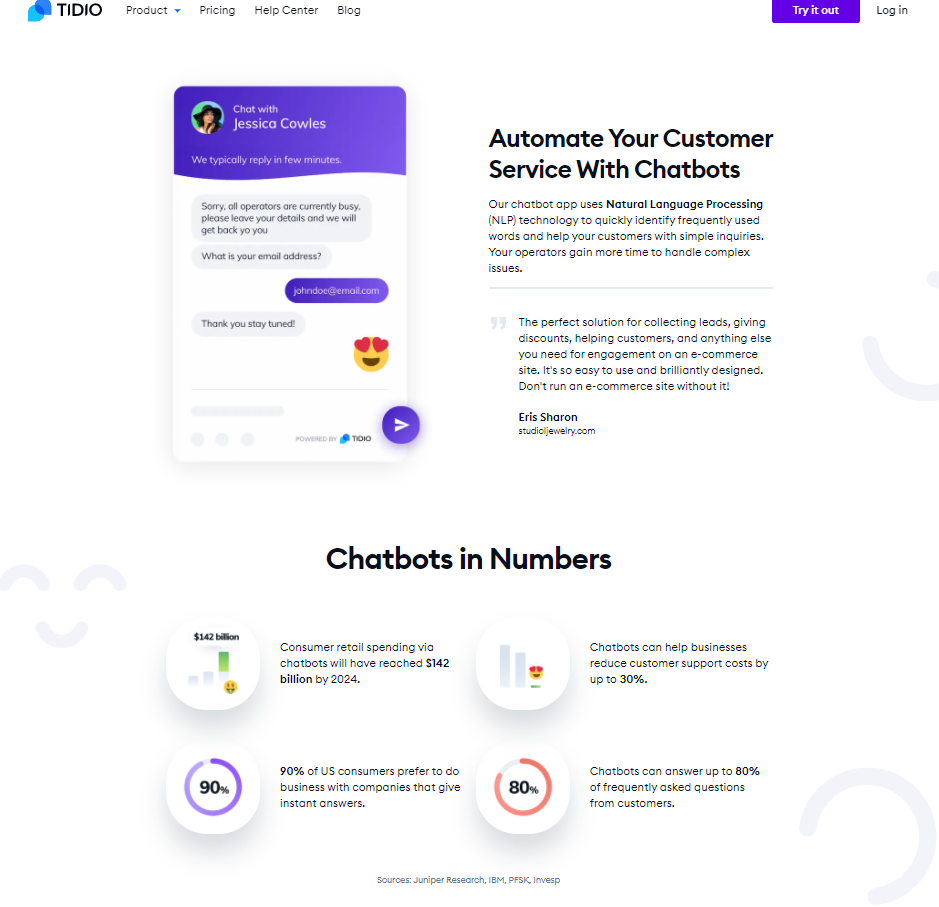
What are other characteristics of a good landing page?
- a clear call to action
- the balance between visuals and text
- structured text
- appealing colors
- use of whitespace between elements
It looks easy in theory but is somewhat hard to execute in practice. So, expect to remake your landing pages several times until you reach the desired result.
3) IKEA and smart international marketing
The beauty of digital marketing is that it can help a brand reach consumers from any part of the world. The crucial factor here is to make sure you cater to the right needs and speak the same language as the target audience.
IKEA is one of the brands doing international marketing right. For instance, it has a separate Instagram page for each country. Here’s IKEA’s page in French:

You can also find pages in Spanish, Russian, Italian, and other languages.
What else is remarkable about IKEA’s digital marketing strategy?
Even though IKEA is trying to cater to different audiences, it has a pretty consistent strategy across all platforms. You will notice that IKEA uses the same theme and colors for all marketing channels, making its products easily recognizable.
The brand also successfully leverages the latest technologies to optimize the customer experience. In an interview with Capgemini, Barbara Martin Coppola, the CDO of IKEA, shares that the company has implemented 3D modeling to give design suggestions to customers on how to style their homes based on their budget.
IKEA’s example shows that digital marketing benefits any company if you know how to leverage data to answer the customer’s pain points.
4) SEMrush and creative online ads
Keeping your focus on organic traffic is definitely worth it, but let’s be honest – it can take ages to pay off. That’s why there’s a good practice to combine organic and paid traffic efforts for maximum exposure.
But not every ad is successful. The consumer needs to be persuaded to click on your ad, and it requires an original idea that targets your product and a consumer’s biggest pain point at the same time. But it’s not impossible. Just take a look at SEMrush’s ad on YouTube:

The brand took inspiration from The Lord of the Rings and personified its tool as the one ring that rules all areas of digital marketing. This way, SEMrush figuratively shows that its comprehensive solution can solve any digital marketing-related task.
How can you come up with an idea like this?
It takes creativity to craft such an ad, but it also shows how well SEMrush’s marketing team knows the tool and how it can help the consumers. When you know your brand and target audience well, it’s easier to draw inspiration from everything.
5) Starbucks and its lucrative loyalty program
Loyalty programs have been around for ages, but digital marketing has amplified its role even more. Now, it’s possible to access your account and review the bonuses via a mobile app and get pre-sale notifications via email.
Starbucks is one of the brands that has learned how to answer customer’s needs and reward them with a loyalty program. Every consumer using the brand’s app can collect rewards and exchange them for any goods sold at Starbucks. They also can get notifications of the latest promotions in their area:

How does Starbucks create value?
Here are some insights based on the case study by Harvard Business Review:
- Flexibility to pay for the order before arriving at the store for faster pick-up.
- A wide variety of rewards (from free refills to free drinks on birthdays).
- Access to special member events.
- In-app purchase of gift cards.
- Members are the first to find out about the upcoming promotions.
It’s also worth mentioning that a loyalty program is an excellent way for the brand to collect valuable customer data, helping it achieve success in digital marketing overall.
6) Function of Beauty and personalized product offers
What does it take to sell a product to a customer nowadays?
Apart from advertising the perks of your product, you also need to create a unique value proposition. In other words, a successful sale is about personalization.
Which personalization methods are currently trending in marketing?
The list is quite extensive. But, according to Statista, inline content is at the top, meaning that marketers prefer personalizing their offers in a way that won’t make them a hard sell:

What are the examples of such content?
It can be a landing page with a quiz asking questions to find out the customer’s individual needs. Function of Beauty uses one of such quizzes to figure out which hair care products to offer to a client:

As a result, you get a selection of highly customized products (even with your name on them). Function of Beauty is an excellent example of why personalization via content is a fantastic digital marketing practice and why it makes sense to focus your strategy on it.
Does personalization affect sales?
Yes, and some studies prove it. For instance, research published in the Journal of Database Marketing has shown that personalized promotional emails have significantly higher click-through rates than non-personalized ones. Besides, timely product information can increase sales, and personalized ads are considered less intrusive.
7) HubSpot and its learning hub
Finally, let’s talk about blogging as a part of online marketing.
A blog is a tool that can help a business build authority in its niche. Some brands (B2B, SaaS) rely on blogging more than others (e-commerce), but this strategy has equal value for every business, regardless of the industry.
That being said, it isn’t easy to build a successful blog. It requires consistency and ongoing optimization if you want your blog to appear at the top of search results. That’s why it takes brands years to create a great blog from the bottom up.
But is it worth the effort?
Absolutely, and you can see how successful the blog can be from the examples of brands like HubSpot, which has turned its blog into a learning hub by adding guides, e-books, and templates:

If you investigate this content closer, you will discover that it’s gated, which means that a visitor has to provide their contact details first to get access to it. This is a great lead generation practice that is advantageous to any company—you offer a fair deal by giving something valuable in return for the prospect’s name and email address.
25 Core Digital Marketing Metrics and KPIs
Indeed, digital marketing can take your business to the top and help you outrun your rivals. But there is no point in beating your brains out and wasting your time if you’re not tracking the results of your efforts.
It goes without saying that each online marketing campaign should pursue a specific goal. In turn, every goal should include a bunch of metrics and KPIs that would indicate the campaign’s success.
This section will cover the most common digital marketing goals and KPIs and metrics needed to track them.
Goal #1: Website traffic
The answer is pretty simple – it’s the only way to find out if it’s working or not. For instance, you’ve just created a landing page, and traffic is one of the core indicators showing whether you’ve built and optimized it correctly.
Here are the five main metrics to measure website traffic.
1) Number of visitors/users
This metric is pretty straightforward – it shows how many people are coming to your website. In Google Analytics, it will calculate the total number of people that come to your website from various sources:

What if the number of website visitors is too low?
First of all, don’t panic. If your website is new, it will take Google some time to rank it. Besides, if you haven’t built enough backlinks to your website, people might be having trouble finding you.
However, if your site has been around for a while, here are potential reasons why the number of visitors to your site is dropping:
- Bad user experience. Consider improving your website’s UX.
- Poor SEO optimization. Improve your strategy around website optimization, keywords, and technical SEO.
- No mobile optimization. Talk with your web developer about possible changes to make your website mobile-friendly.
- Broken links. Regularly monitor your website for links that have redirects or don’t work at all.
- Outdated information. The simplest of problems – update the content on your website regularly as it may misguide new visitors.
Also, don’t fret if you’ve noticed your number of visitors dropping after updates to your website. But make sure to check the load time, especially if you’ve made changes to the website’s design.
2) Top traffic source
The top traffic source is the place that generates the most traffic. Here’s how this metric will look in Google Analytics:
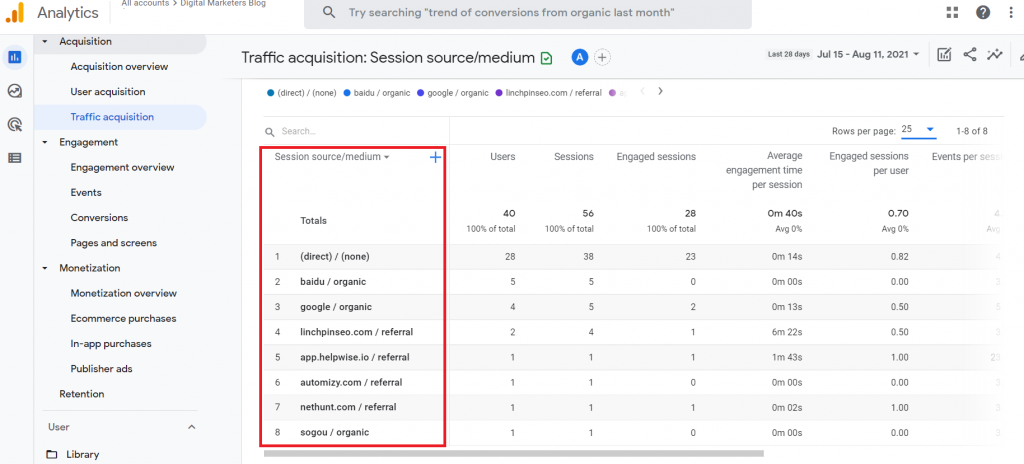
Where are these channels coming from?
They are the result of your search engine optimization efforts, link building, and referral campaigns. If you post a link on your social media accounts, traffic can come from there too.
3) Users by traffic source
This metric indicates the number of users coming from each traffic source:
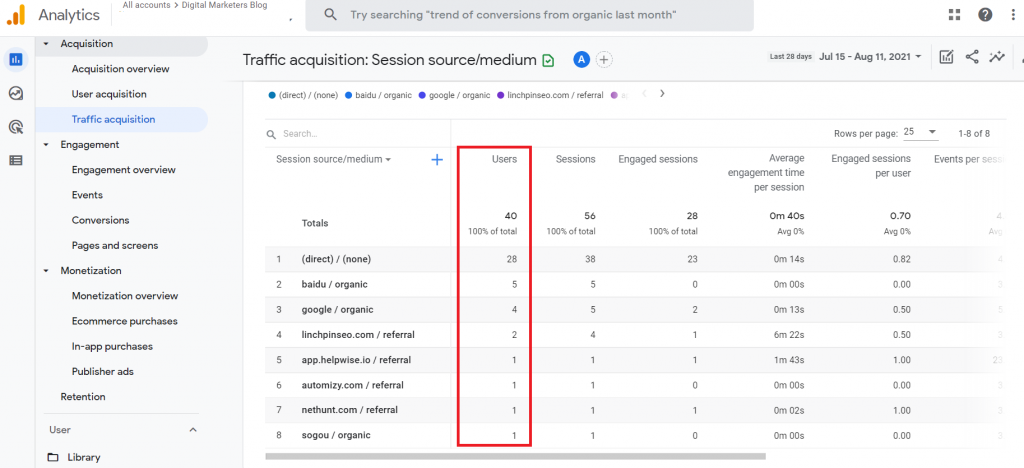
You can use the users by traffic source metric to figure out whether traffic optimization has given results. Besides, it can come in handy during your future campaigns, helping you figure out the best traffic source to focus your marketing efforts on.
4) Average engagement time
In terms of traffic, how much time people spend on each of your pages matters a lot. Take our landing page example, for instance. If people bounce from it too fast, it’s not optimized well enough, and you might need to rethink its design and content to boost engagement.
You can check the average engagement time in the Page and Screens tab in Google Analytics:
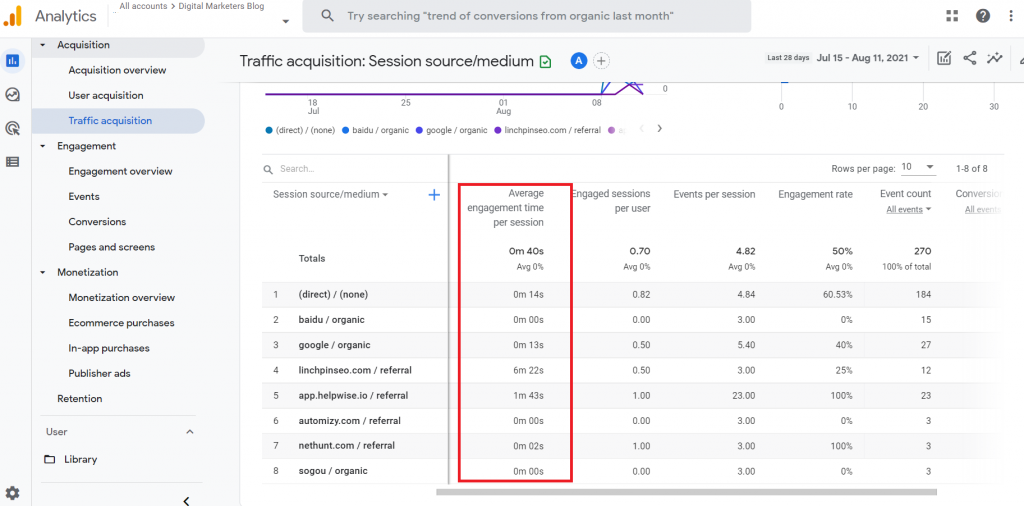
This is the time users spend on each of your website pages on average. You can also check the average engagement time per session/source in the Traffic Acquisition tab:

What if visitors bounce too fast from your website?
Here are the most common reasons:
- low-quality content
- broken pages
- slow-loading site and pages
- misleading information
- no mobile optimization
Keep on a sharp lookout for the percentage of the bounce rate. Here are some insights from Search Engine Journal as to what a good bounce rate looks like:
- 25% or lower – problems with the website
- 26%-40% – normal
- 41%-55% – average
- 56%-79% – either normal or could indicate problems
- 70% or higher – bad
Remember: before ringing the alarm, consider the average bounce rates in your industry – what’s deemed normal in SaaS might not be good in e-commerce.
5) New users per page
You can also check out how many new users have visited each of your pages. It can be especially handy if you’ve built links to them and want to check out if your efforts were successful:
This metric is accessible via Google Analytics in the Page and Screens tab:
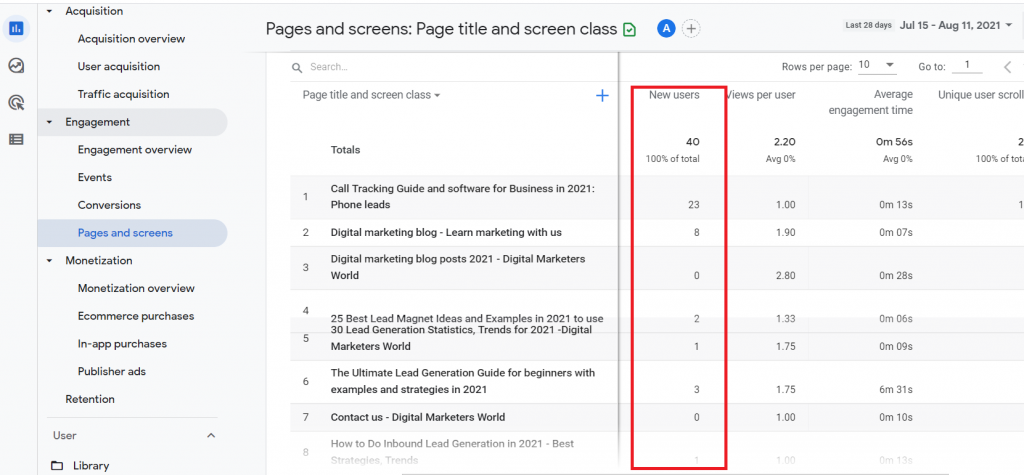
Google Analytics generates this metric via the first open event when the user clicks on the link for the first time. However, each click coming from a different device counts as a new visit, even if it’s the same user.
Goal #2: Lead generation
Lead generation is one of the most common goals in digital marketing. It’s the process of acquiring new prospects and nurturing them up until they agree to buy from you.
The metrics that measure lead generation help you understand whether your marketing techniques affected your prospects and how fast they convert into buying customers.
1) Conversions
Conversion in digital marketing means the process of a lead becoming a buyer. High conversion rates mean that a prospect responds well to your lead generation and nurturing efforts and is convinced that your product caters to their needs.
Here’s the formula for conversion rate:

Total attributed conversions are the total number of buyers you’ve acquired via a single medium, such as a click. You should review each conversion case individually to determine whether it has brought the expected result.
The total number of measured clicks indicates the times a prospect clicked on a lead magnet.
What are the reasons for low conversions?
Most probably, the value proposition you’re making with your lead magnet is not relevant to your target audience. It is also possible that the quality of content is poor.
Other reasons include:
- A slow-loading page.
- Incomplete product information.
- Low-converting CTAs.
- A too intrusive approach.
2) Click-through rate (CTR)
A click-through rate (CTR) indicates the number of people who click on a specific link placed in an email, ad, or landing page. The more people click on the link, the more ready-to-buy prospects you have.
The CTR formula is the following:

The total number of clicks indicates the number of times prospects clicked on a link in the lead magnet.
The total number of impressions is the times people viewed a link magnet (an email, an ad, and so on).
What should you do if your CTR is not what you expected?
CTR is one of the digital marketing metrics which mainly depends on the quality of the content where the link is placed. If the value proposition is irrelevant, the quality of content is poor, or the CTA is not convincing, these might be the reasons why you don’t get enough clicks.
3) Lead velocity rate (LVR)
Lead velocity rate is the percentage indicating the growth of leads each month. It’s a pipeline development metric that shows how fast and effective your lead generation funnel is.
Here’s what the LVR formula looks like:

Why track lead velocity rate?
It is one of the critical metrics if your goal is to grow your business. It predicts your future revenue and reflects the success of your lead generation efforts.
To get the most out of your LVR, you should track it along with the number of SQLs and closed sales. Also, if you think your LVR can be affected by seasonal dips, you should take it into account as well.
4) Cost per acquisition (CPA)
A cost per acquisition (CPA) metric shows how much it costs to get one new paying customer. If your lead generation campaign involves multiple channels, each of them will have its individual CPA.
Here’s the formula to calculate the CPA:

The total amount spent indicates how much money went on each marketing activity.
The total attributed conversions show the number of actions that led to a lead becoming a buyer.
How to reduce the high cost per acquisition?
First and foremost, analyze your lead magnet. Whether it’s a landing page, a template, or an ad, it might need further optimization.
You might also want to give retargeting a try, especially if you have many abandoned carts. You might also want to stop advertising in geolocation that brings little to no buyers. And, since we’re talking about ads, you can try lowering your bids for the keywords or reconsider your keyword optimization altogether.
5) Retention rate
Retention rate represents the number of people who remain your paying customers. It is often put alongside the churn or attrition rate, which indicates the percentage of people who no longer buy your products.
Here’s how you measure the retention rate:

Why do customers bounce?
Among the most common reasons is the low-quality product or service. According to SEMrush, 77% of buyers remain loyal to the brand if the quality of the product satisfies them.
Low retention rates can also indicate the problems in the sales funnel – targeting the wrong marketing channels, poor customer service, and even unoptimized content.
Goal #3: Paid advertising
Although the trend today is to focus on organic means of promoting a business, paid ads are still an inalienable part of digital marketing. They help generate traffic, target a relevant audience, and improve brand recognition almost instantaneously.
Like any other marketing goal, paid advertising only brings results when you know how to measure it. Here are the core paid advertising metrics you should keep in mind.
1) Return on ad spend (ROAS)
This is the most crucial metric to track if PPC ads are in your digital marketing plan. It measures the revenue your business gets for each dollar spent on ads.
The ROAS formula is pretty simple:

ROAS is the advertising variant for ROI because your ad spendings are also an investment. It is also a more meaningful metric than cost per acquisition (CPA) as it directly represents the success of your ad campaigns revenue-wise.
Now, what if your ROAS is too low? There might be a few reasons for that:
- the cost per click is too high
- conversion rates are too low
- average order value is too low
Make sure to investigate and optimize these metrics to improve your ad revenue.
2) Average order value
The average order value (AOV) metric indicates every dollar spent each time a customer purchases something from your website or app. AOV is a benchmark for customer behavior. Thus, its goal is to show you whether the target audience responds to your ad as you expect them to.
Here’s how you calculate the average order value:

Theoretically, you want AOV to be as high as possible since it will mean more revenue and growth for your business. There are a few additional strategies you can employ to increase your AOV:
- cross-selling
- upselling
- coupons and volume discounts
- fair return policy
- free shipping
Also, consider tracking AOV along with other metrics, such as conversion rates and revenue per visitor (RPV). This way, you will have a fuller picture of how to grow ad revenue.
3) Customer lifetime value
Customer lifetime value (CLV or CLTV) is the total revenue a business can expect from a single customer throughout their relationship. Companies usually consider this metric in comparison to the predicted customer lifespan.
You can calculate CLV using this formula:

The customer lifetime value metric is as important as all other metrics in paid advertising since it helps you understand:
- the factors that impact customer loyalty
- what you need to target your ideal customers
- how to reduce customer acquisition costs
- how to increase ad revenue
- how to build a stronger brand-customer relationship from the start
To sum up, CLV is the metric that helps you understand how to promote your business through digital marketing in a meaningful way that would bring you more money and more loyal buyers.
4) Cost per click
Cost per click (CPC) is the basics of PPC advertising. It helps you understand how much to bill an advertiser for the number of times a visitor clicks on your ad.
Here’s how you calculate CPC:

The cost per click metric depends on the following factors:
- keywords
- targeting criteria
- campaign type
- bid strategy
Every industry has its own CPC averages. According to the statistics by Wordstream, the legal sector has the highest CPC rates ($5.88) for search ads. The average CPC across all industries is $2.32. Make sure you are familiar with these numbers before investing in paid ads.
5) Impression share
The impression share metric measures how many people have seen your ad. It is one of the core KPIs in Google Analytics and is especially useful in brand awareness campaigns.
This is the formula to measure the impression share (for search ads):

What if your impression share is underperforming?
Here are a few things recommended by Google:
- Consider improving your bid. The higher the bid is, the more chances your ad gets to appear in search results.
- Decrease regional targets. It may help increase the impression share.
- Improve ad quality. Review quality score components, optimize for more relevant keywords or update the information on your landing page.
You might also need to re-adjust your budget since it controls how often your ad appears and can improve your impression share.
Goal #4: SEO optimization
When you create a digital marketing strategy, SEO optimization will become an inalienable part of it. It is an continuous effort meaning that you need to think about allocating resources to keep it going. And you will need to keep track of SEO optimization metrics regularly.
Here are the most crucial KPIs you should consider.
1) Organic traffic
Organic traffic is one of the primary metrics to consider in SEO – it reflects how successful your optimization efforts are. You can analyze your organic traffic (along with sources) via the Acquisition Overview in Google Analytics:
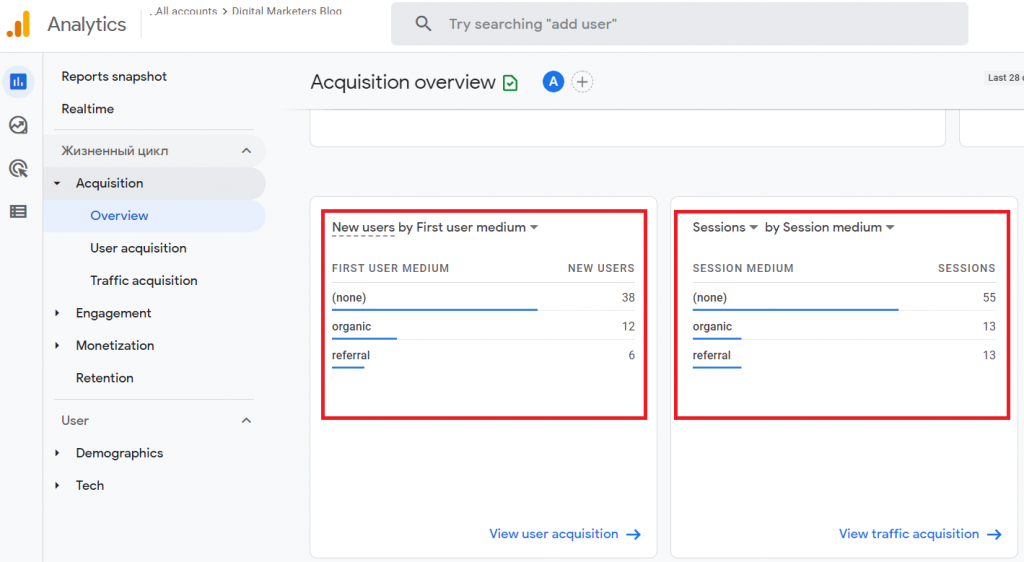
What can cause a drop in organic traffic?
These are some of the reasons:
- changes to your website (website redesign or migration)
- technical issues
- a drop in domain rank
- lost links
- outdated or irrelevant content
Sometimes, a decrease in organic traffic can happen because of Google updates. In this case, wait for the updates to kick in as you optimize your website according to new recommendations.
2) New backlinks
The new backlinks metric indicates how many new websites refer back to yours. You can view the report on this metric in Ahrefs. All you have to do is set the custom timeline:

This metric shows the results of your link building efforts. So, if your search engine optimization campaign involves backlink acquisition, you should continuously track the new backlinks report to make sure none of them are broken or lost.
3) Domain authority
Domain authority represents the website’s relevancy in its industry and subject area. It also shows the strength of your backlink profile.
Even though Google denies that domain authority is the ranking factor, it still impacts how high you get in SERPs because it shows how trustworthy your website is. You can review this metric in the SEO tool of your choice. In Ahrefs, this report is called Domain Rating:

There are a few effective methods for improving your website’s domain authority:
- pay equal attention to on-page, off-page, and technical SEO
- build links to authoritative and relevant websites only
- make your website mobile-friendly
- improve the page load speed
- create social signals
The best thing you can also do is to be patient. It can take Google a while to recognize all your efforts and review your domain authority. The best tactic is to keep creating high-quality content and build a clean backlink profile.
4) Keywords that drive traffic
This metric shows how much traffic a keyword brings to your website. You can review this metric in the Ahrefs’ Organic Keywords report:
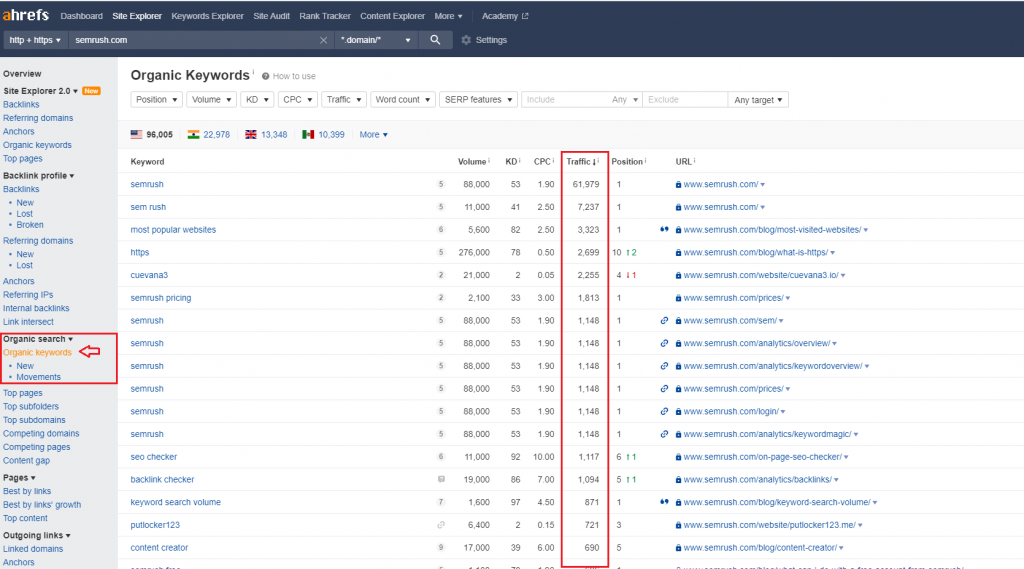
Why do you need to track these keywords?
Monitor this metric over time to analyze and adjust your SEO efforts. You can also create more optimized content around the keywords that bring you the most organic traffic.
5) Conversions from organic search
This metric shows the correlation between the top keywords you rank for and your value proposition. The only way to calculate it is to categorize paying customers by lead sources (in our case, organic search) and dates in your CRM.
What if your conversions from organic search are too low?
The reason might be that the high-ranking keywords are irrelevant to your audience. You should create a campaign around highly targeted keywords that address your target buyer’s pain points.
Goal #5: Social media marketing
When you start digital marketing, social media becomes an inalienable part of it. It also plays a role in SEO optimization since social signals can potentially improve your visibility in SERPs and, possibly, domain authority.
If you decide to do social media marketing, you want to do it right. Here are a few metrics you need to monitor to improve your results.
1) Traffic from social media
This metric indicates the total traffic coming to your website from social media networks. For instance, it can come from a tweet you’ve recently posted if one of your followers clicks on the link you put in it.
Social media traffic can be tracked via Google Analytics—it will be displayed as social traffic alongside organic, referral, and paid search sources.
Why does social traffic matter?
Even though the main focus is on organic traffic today, the more diverse your website traffic profile is, the better. Your solid social media presence can also help you generate more converting traffic. And, your social media accounts can also be a +1 point to building authority in your industry.
2) Engagement
Engagement is the metric indicating how your followers respond to your social media content. You can review this metric in the Analytics tab of each respective social media platform. Here’s how it looks on Facebook:
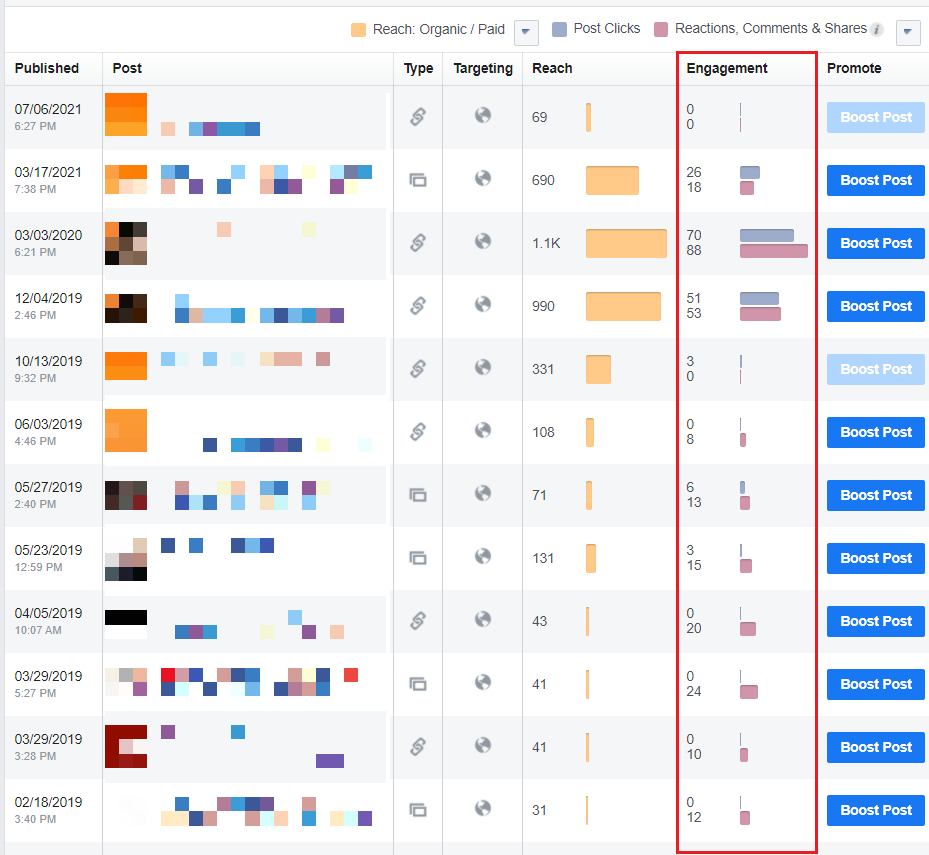
What if your engagement is too low?
As we mentioned, social media engagement is tied to the quality of content you’re uploading. If your followers find it not interesting or irrelevant, your engagement rates will reflect it.
Humanizing your brand can also help boost interest in your brand. Post content featuring people working for your business and what happens behind the scenes.
3) Reach
You can also track the reach for each of your social media posts. On Facebook, this metric can be found next to the engagement column:

Why is your social media reach low?
The reason might be the inconsistent posting schedule. You’re probably posting too much, or your content doesn’t appear at the right time. That’s why it is also important to know the times when your audience is most active and align your posting schedule with it.
Using hashtags can also help increase your reach. However, make sure you include hashtags that are relevant to your audience. Otherwise, you risk targeting the wrong people.
4) Audience demographics
If you want to create social media content that’s high in value, understanding your followers is a must. That’s why you need to be familiar with audience demographics, which you can check out in the Analytics tab. Here’s an example from Facebook:
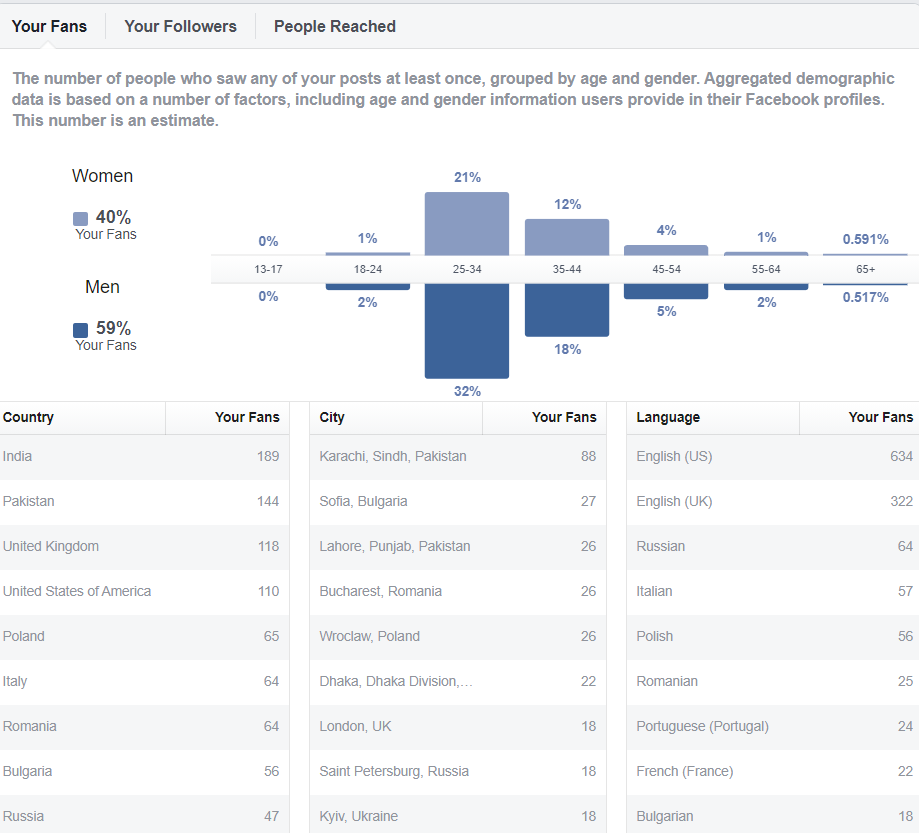
Audience demographics can help you understand your audience’s interests and needs and create more targeted content.
5) Social media ROI
You need to know that all your social media marketing efforts pay off. Social media ROI is the metric that can help you figure that out. Here’s how you calculate it:

Social media ROI can be less tangible than lead generation ROI and will depend on the goal you want to achieve. If the ROI is too low, consider the following factors:
- Are you targeting the right audience?
- Does your content reach enough people?
- What is the click-through rate of posts, including links to product pages?
Social media ROI is not the metric that validates the importance of your social media strategy. Its primary purpose is to show you the areas of improvement and ideas for better social media performance.
6 Main Digital Marketing Channels
You already know that digital marketing affects consumer behavior in various ways and through different channels. A template sales funnel usually relies on multiple media to reach consumers and educate them about the product or service.
What are these channels? What is their role in your digital marketing strategy?
Let’s take a look.
1) Website
A website is a must-have for any business today, no matter whether you’re selling online or offline. This channel is your chance to take your rightful place in your niche and industry and start growing your authority.
What are the tasks of a website?
- attracting more customers to your business
- introduce your product/service to your audience
- add instant credibility to your brand
- make your business discoverable in SERPs
- make your company open to new customers 24/7
There are also a few fundamentals a high-quality website should have:
- straightforward, up-to-date content describing your business and product
- a short and simple URL
- an easy-to-navigate sitemap
- an actionable CTA
- SEO optimization
- accessible contact information
- a reliable hosting platform
All these features should come together powered by a simple and clean design that makes them stand out. SEMrush is an excellent example of a website build with quality and consumer needs in mind:

Since it’s an SEO tool, SEMrush focused its website design on its most popular features– keyword and domain analysis. To show that the resource is trustworthy, SEMrush also added testimonials from the top brands using it.
What are the trends in website development for 2022?
Besides doing digital marketing for your website, which will always remain a must, you should also focus on implementing the following tendencies:
- AI and bots. An AI-powered chatbot is a feature that makes your business available around the clock. This technology keeps developing, making chatbots more receptive to human speech. The goal is to make every chatbot-customer conversation resemble human interaction.
- Voice search optimization. The popularity of smart home assistants keeps growing, which also impacts the need for more optimized voice search. One of the ways to make your website move voice search-friendly, optimize it for featured snippets.
- Mobile-first development. Mobile website traffic now comprises 54.8% of the entire traffic volume, which means that more than half of internet users browse websites via mobile devices. So, there’s no excuse not to invest in mobile-friendly website development.
A website requires ongoing investment. So, make sure you have a budget allocated for website changes and updates.
2) Email
Rumor has it that email marketing is dying. In reality, it’s far from the truth. Email marketing is alive and well, and businesses actively use it to generate leads and nurture prospects.
How do you create a compelling email?
- a clear and engaging subject line
- a preheader indicating the goal of the email
- an informative and interesting copy
- eye-catching design
- a persuasive CTA
An email is also a branding opportunity for your business – an addressee should be able to recognize it from the first look at your message. For instance, you can include your company’s logo and your signature colors. Holo Taco, a nail polish brand, also adds relevant emoji to the email subject line:
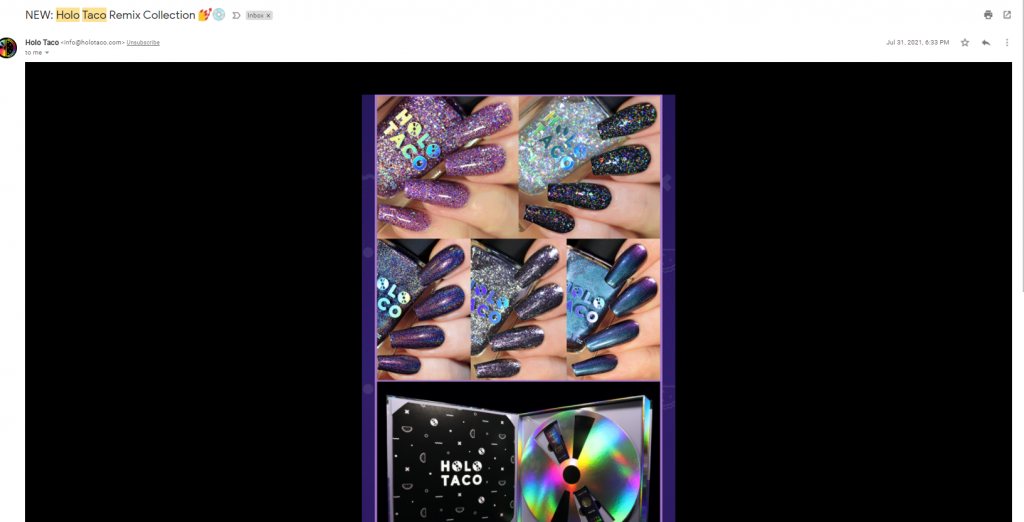
Crafting a good email is easier said than done. Most likely, you will have to A/B-test and re-adjust it several times before sending. Your main focus should lie on catering to the needs of your target audience and personalizing your offer.
3) Content marketing
Content marketing supports digital marketing. It’s everywhere: websites, blogs, social media, email, paid ads. Content is your primary means to educate consumers about your product and persuade them that they need it.
What are the essentials of a content marketing strategy?
- a well-defined target audience
- a clear goal
- definitive KPIs
- a mix of content distribution channels
- the right content type
A robust content strategy revolves around a target audience, its needs, and how precisely you can determine them. For instance, Bresser, a German manufacturer of telescopes, understands that its customers might have difficulty assembling telescopes. That’s why they’ve created a series of assembly videos:
Putting your audience first is one of the best practices in content marketing. The others include:
- a data-centric approach to content creation
- multi-channel content marketing
- SEO optimization
Crafting high-quality content can be quite a challenge – your task is to create a perfect fusion of branding and value. It can take you a while to figure out your content strategy, but it absolutely should be a part of your digital marketing efforts.
4) Social media
If you want to grow your business, including social media in your digital marketing strategy is necessary.
Why?
You have the potential of reaching a diverse audience: if you have active Facebook and Instagram accounts, you can potentially reach over 4 billion people. And doing video marketing via YouTue adds another 2 billion to that number.
Social media platforms also enable direct communication between you and your audience. For instance, Payoneer connected its multilingual customer service to reply to customer inquiries on Twitter:
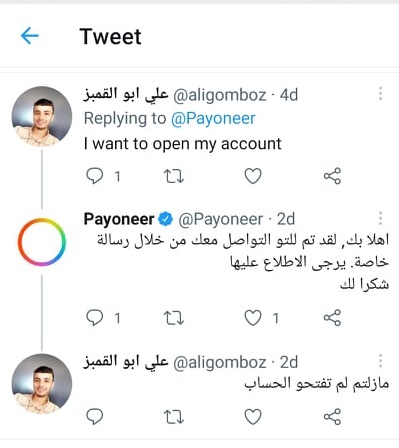
Which platform is the best for social media marketing?
It’s relative, and the answer will depend on your industry, niche, and audience.
For instance, a SaaS or a manufacturing business would thrive on LinkedIn. At the same time, an e-commerce store might want to focus on Instagram, Facebook and involve messengers like Telegram or WhatsApp to send order updates.
However, it doesn’t mean that a SaaS business cannot use Instagram for social media marketing. For instance, Microsoft created an Instagram account to share behind the scenes and updates:
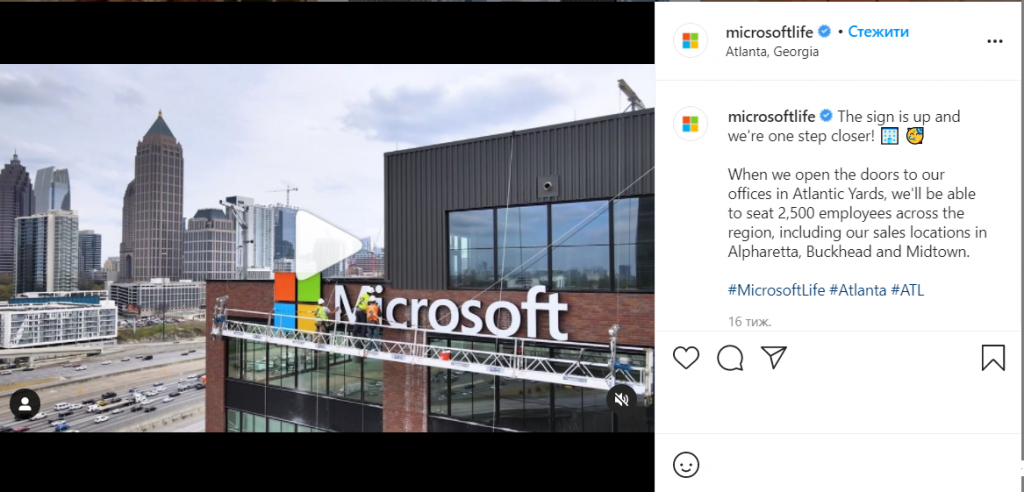
Social media platforms are pretty versatile and give any business opportunities to thrive and grow. But opt for a platform where your audience is the most active.
5) SEO
Search engine optimization is the foundation of modern digital marketing. Since the main focus today lies on organic traffic, you cannot dismiss the importance of SEO – it’s one of the main ways to get your brand noticed and recognized.
What are the most crucial SEO components you need to get right from the start?
- Your target audience and industry. These components will impact your keyword research and other SEO factors.
- Keyword research. Without it, you won’t be able to target the right search intent that corresponds to your target audience’s needs.
- Original content. You need to ensure there is no duplicate or irrelevant content on your website.
- Off-page SEO. Focus on tasks such as link building, social media marketing, participating in expert round-ups, and other activities that would improve your website’s authority.
- Technical SEO. Keep your eye on indexing, crawling, rendering as well as website architecture.
How do you measure your SEO efforts?
It’s a pretty hard thing to do by hand. While you could do keyword research via Google Keyword Planner, you still need to monitor your domain authority and look for link building opportunities and content gaps.
That’s why you cannot go without an SEO tool. For instance, SEMrush has all the features necessary for on-page and off-page SEO. You can even generate a site audit report with technical SEO insights:

SEO optimization is an ongoing effort – you should be on a constant lookout for new keyword and link building opportunities. Besides, Google keeps coming up with the latest updates, and it depends on you whether they will make or break your website.
6) Online ads
Even though most of your digital marketing efforts should focus on building organic traffic, online ads still remain among the most effective methods to promote your brand.
There are five main online advertising options you can choose from:
- Native ads. Also known as sponsored content, these ads match the form and the content types used by a platform that displays an ad. For instance, ads will appear as posts with images/videos or as Stories on Instagram:

- Search engine marketing (SEM). These ads are tied to a particular keyword/search query and will appear on the top of search results:
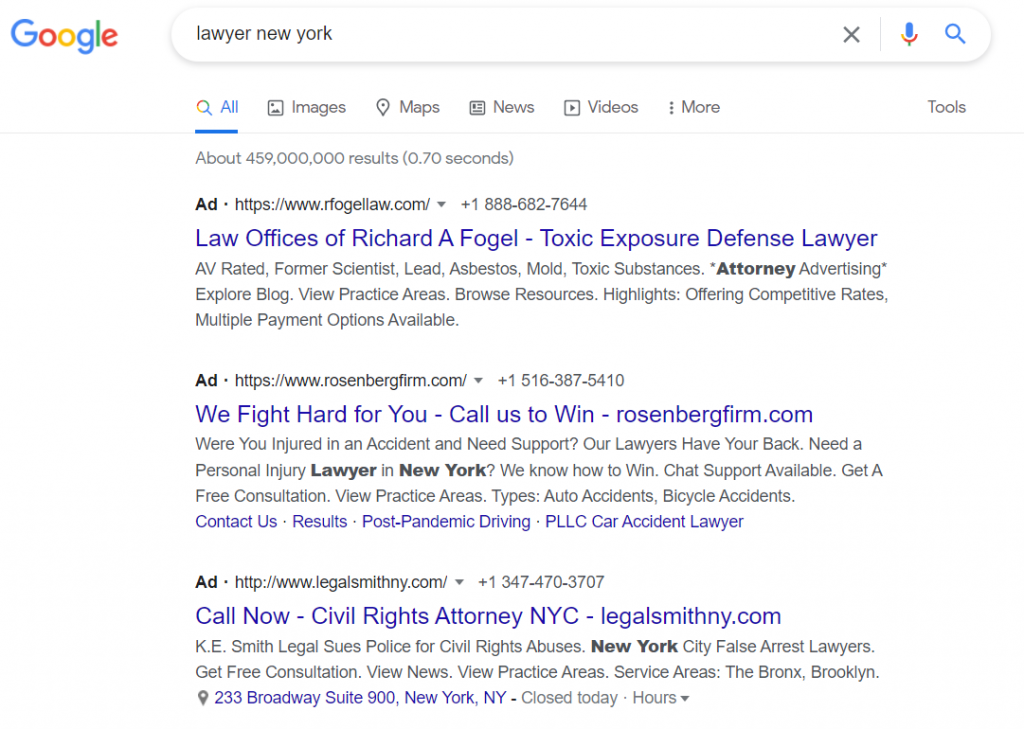
- Display ads. These ads appear in designated places on a website or blog. You can purchase them through services like Google Adwords that have partnerships with certain websites:

- Social media ads. These ads are created and managed through social media platforms. In certain instances, they can be confused with native ads since they take the form of the content attributed to a specific social media network:

- Mobile ads. These ads appear in apps used on mobile devices. They can show up as text, image, and video ads. Also, there are specific image requirements.
How to choose the right online ad type?
You should consider your budget and the preferences of your target audience. But, on a general note, online ads are usually quite affordable, even for a startup or a small business.
The Role of Lead Generation in Digital Marketing
It’s hard to imagine online marketing without lead generation. The truth is, it takes a while for a prospect to convert to a paying client. And you hold power to influence their decision.
With that in mind, lead generation is tough to execute. Reportedly, 58% of businesses struggle with attracting relevant prospects, which can happen either because their goals are not correct or the target buyer persona is not specific enough.
Apart from that, generating leads is not enough if your goal is to get more customers. You should pay equal attention to lead qualification to attract only relevant buyers who have the potential to become your loyal customers.
Lead qualification is the process of determining if a prospect fits your ideal buyer profile. There are two main types of leads in digital marketing lead qualification focuses on:
- Marketing-qualified leads (MQLs) – express interest in your brand and product after interacting with your content.
- Sales-qualified leads (SQLs) – are already here to buy your product.
Usually, it takes time to turn a marketing-qualified lead into a sales-qualified lead, and that’s why you need lead nurturing – a process of building and facilitating relationships with customers on each stage of the sales funnel.
Thus, lead generation doesn’t stop at creating lead magnets and collecting contact information from prospects. Your task is to guide potential customers through the entire funnel and nurture them until they are ready to buy from you.
Inbound and outbound lead generation in digital marketing
Lead generation can be inbound and outbound. These concepts are often put against each other, and inbound lead generation is considered a more ‘organic’ strategy. Meanwhile, they can both coexist and help you generate high-quality leads.
Inbound lead generation is a process of creating and promoting targeted content that appeals to the target customer. The goal is to establish communication and make personalized offers based on the customer’s needs.
Inbound lead generation strategies include:
- SEO
- content marketing
- social media marketing
- product demos and trials
- email marketing
- chatbot marketing
As you can see, some of these strategies coincide with the types of online marketing we’ve discussed a bit earlier. That’s because inbound lead generation uses methods that would gradually convert a customer by increasing their awareness about the brand and the product.
Outbound lead generation focuses on finding and engaging with potential customers who don’t know about the product yet. When prospects discover your product—it is called inbound lead generation. When your brand initiates the outreach—it’s an outbound lead generation.
Outbound lead generation uses different methods to help you find relevant leads:
- cold emails
- cold calling
- syndicated content
- social media outreach
- events
- referral marketing
Paid advertising is often considered both inbound and outbound lead generation strategy. On the one hand, you post online ads to make more people aware of your brand. On the other hand, if you use retargeting ads, you focus on people who’ve already visited your website and, therefore, know about your product.
Can you do digital marketing from home?
In the wake of the pandemic, the demand for remote teams has significantly increased. It made us wonder – is it possible to run all digital marketing operations from home? And how effective can such marketing campaigns be?
According to our quick LinkedIn survey, most experts deem it possible to do digital marketing from home. However, they highlight that face-to-face teamwork has added benefits:
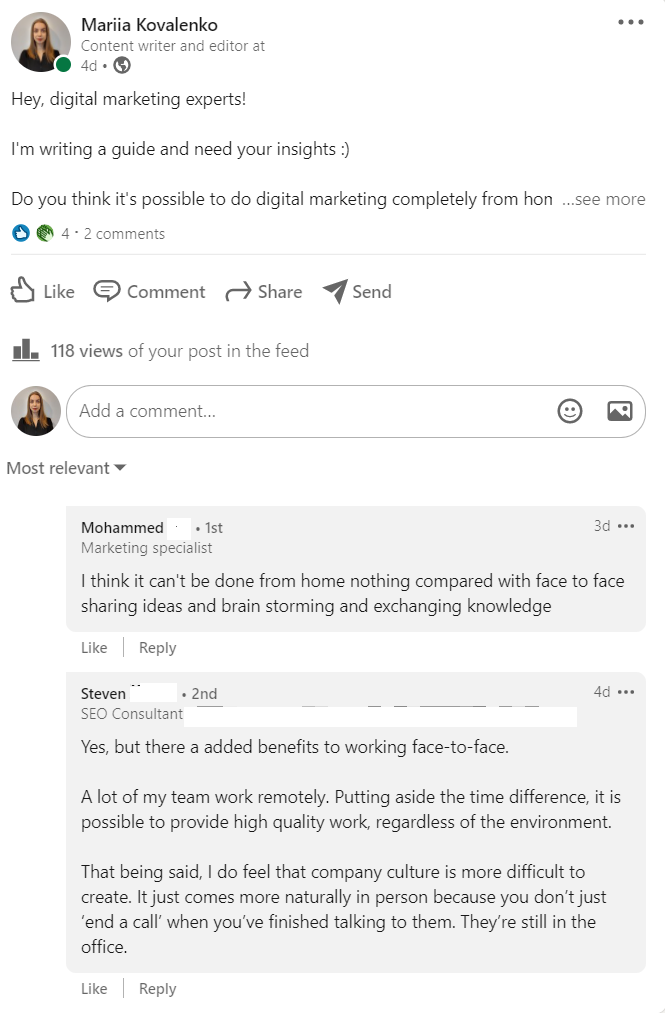
So, according to the experts, face-to-face interactions facilitate innovation and a productive work environment. Besides, it is easier to create a company culture when the digital marketing team is together in one office.
However, we all understand that, in the current circumstances, it is hardly possible to bring your team together offline. Luckily, today, we have no shortage of tools that help us measure KPIs in digital marketing and check the results of a campaign without leaving the house.
Besides the tracking tools, your team will also need reliable hardware – a laptop or computer that would sustain their needs. For instance, a good laptop for marketers is MacBook Air – it has a strong CPU, enough storage, and battery life to work all day without interruptions.
Is outsourced marketing a good option for your business?
If you don’t have the budget to hire an in-house digital marketing team, then, by all means, go for an agency. It will cover all your online marketing needs, from content creation to SEO and link building. But make sure you choose professionals that will keep you up-to-date and run every decision by you before bringing it to life.
How to Allocate a Digital Marketing Budget
There’s no doubt that a brand can barely survive under the present competitive conditions if it doesn’t have a solid digital marketing strategy.
But how much should you be spending on online marketing? How much is too much?
Here are a few tips on how to allocate a budget for digital marketing.
1) Define detailed goals
The ultimate goal of digital marketing is to help you improve sales. Here, you can take two perspectives – a long-term or a short-term one. In the first case, your efforts will be focused on selling as much as possible in a short period of time. In the second instance, you’ll be focusing on brand awareness to build a long-lasting relationship with your potential buyers.
These two perspectives will also define your goals. So, if you want to increase sales as fast as possible, you should reach the following objectives:
- improve conversions
- optimize sales funnel (i.e., with the focus on dormant customers)
- increase traffic to your website
Conversely, if you’re planning to raise brand awareness, setting the following goals can help:
- improving organic traffic
- attracting more social media followers
- getting more clicks and impressions for your content
These are just a few examples of what a digital marketing goal can look like. To estimate your budget, focus on your current business needs and align them with the needs of your target audience.
2) Review previous results
Let’s say you invested $10K in social media ads last year to generate more revenue and yet saw no positive ROI. We’ll agree that investing more in this digital marketing channel doesn’t make sense until you figure out why your efforts haven’t paid off.
This is why you can’t move on with your budget until you thoroughly analyze your previous campaigns and draw lessons from them. Here are a few questions you can ask yourself in the process:
- Which marketing channels have brought you the most revenue? Does it make sense to keep investing in them?
- Which of your investments didn’t get the results you expected? What was the reason?
- What was the final ROI for each of your previous campaigns?
- Which of the marketing channels performed well but worsened over time?
- Do you want to make any long-term or short-term adjustments to your digital marketing strategy?
Make sure to answer all these questions using metrics and data. Work closely with the sales team to collect as many insights as possible to calculate the digital marketing budget.
3) Choose digital marketing channels
Once you have collected the data from your previous campaigns, it’s time to choose digital marketing channels that will lay the foundation of your next marketing campaign.
As you already know, you can choose among six online marketing channels:
- website
- content marketing
- social media
- SEO
- paid ads
You can target several channels at once, but make sure your choice is aligned with your goals. For instance, if you want to increase brand awareness, you can try a mix of organic channels and paid ads for maximum results.
4) Decide if you want to outsource
If you’re planning to hire a digital marketing agency, it can be a turning point for your budget. You won’t have to allocate the money for each channel. When you hire an agency, you pay for everything in bulk.
What can a digital marketing agency do for you?
The answer depends on the type of agency you hire. For instance, an inbound marketing agency will only focus on inbound channels (SEO, content marketing, social media marketing, email marketing), while a full-service digital marketing agency can also cover outbound channels (cold calling, cold emails).
So, make your decision based on your needs. If you have a few content writers but lack an SEO specialist, hiring an SEO agency can help you reach your goals. Also, if the money you spend on digital marketing doesn’t pay off, giving an agency a try can help you figure out what you’ve been doing wrong.
5) Calculate the final budget
Once decisions are made, it’s time to make the final one and estimate your budget for digital marketing. At this point, you can take either of these routes:
- Focus on affordability. You simply estimate how much you can afford to spend on marketing. It’s a rather subjective way to calculate your budget, but it’s feasible, especially for a startup with no experience in digital marketing.
- Prospect sales possibilities. You can either look back at the sales campaigns, see how they did or try to predict the possible revenue you will receive from an upcoming campaign and use these estimations to figure out the budget.
- Get ideas from your competitors. How much did they spend on their campaigns, and were their investments fruitful? The experience of your rivals can give you insights into what your digital marketing budget should be.
It’s always best to collect as much data as possible, including from competitor analysis, to understand how to build a smart digital marketing budget. So, try to be as objective as possible, even if you don’t have much marketing experience.
5 Common Digital Marketing Mistakes
While having a digital marketing strategy is a must in this day and age, you can hardly find a company that hasn’t made any mistakes along the way. Mistakes are a natural part of a learning process, but sometimes they can cost you an arm and a leg.
So, let’s take a look at the five most common digital marketing mistakes you should watch out for on your journey.
1) Being overly promotional
Since the primary goal of a digital marketing strategy is to sell (often, not directly), it’s hard not to use every opportunity to force-feed your product on every possible occasion.
Nevertheless, you should be extremely cautious as to how and when you’re doing promotions. Since 90% of your efforts will most likely be focused on organic traffic and SEO optimization, trying to stuff every digital marketing channel with content that implies a hard sell is a bad idea.
The same goes for your link building strategy. According to Google Webmasters, excessive link exchanges and even large-scale article marketing can be deemed inappropriate and lead to the search engine banning your website.
What you should focus on instead is creating a digital marketing strategy that increases your authority. When consumers know that you’re a recognizable brand, they will be more eager to buy from you.
2) Failing to recognize your customer’s needs
In digital marketing, it’s a rule of thumb that no strategy or campaign can launch without a properly defined target audience. It’s the only way to create targeted content that interests and engages your potential buyers.
Unfortunately, it’s easier said than done. The first mistake that brands make is targeting as many consumers as possible, saying they want their audience to be diverse. In reality, you’re decreasing the chances of reaching your ideal customer.
What you should do instead is focus on describing the following details as precisely as possible:
- Demographics: age, gender, language, location, job, income, marital status, education, etc.
- Psychographics: interests, hobbies, needs, challenges, purchase behaviors, etc.
The ideal target buyer definition is something you should develop using the consumer data available to you. So, mine your CRM software, browse social media analytics, and study customer purchase patterns to understand why and how people buy your product.
3) Underestimating the importance of SEO
Although critical, writing authoritative content and being active on social media is not enough for a successful digital marketing strategy. You need to go the extra mile and invest time and effort in search engine optimization.
First of all, SEO drives 1000% more traffic than organic social media. It doesn’t mean that you should neglect your social media marketing strategy. Social traffic still matters, but your primary focus should lie on SEO.
Next, if you want more people to recognize your brand, you need to get to the first page of SERPs – a destination that’s impossible to reach without optimization. You will need to do keyword research and make your content match the right search intent on an ongoing basis to get your chance to rank higher.
Finally, your SEO efforts translate into brand authority. The more you optimize your digital marketing strategy, the more you become perceived as a credible source in your industry.
4) Generating leads and not nurturing them
Lead generation is undoubtedly one of the crucial tasks in online marketing, but it’s hardly worth your investment if you don’t focus on lead nurturing as well.
You’d be surprised, but, according to InvespCRO, only 35% of B2B marketers have a lead nurturing strategy in place. Meanwhile, the same source emphasizes that nurtured leads are 50% more likely to buy and make 47% larger purchases than non-nurtured leads.
So, a lead generation campaign should include a set of lead nurturing tactics. Here are some of them:
- targeted content
- audience segmentation for personalized offers
- retargeting
- multi-channel marketing
- follow-ups
Every sales funnel stage should include some kind of lead nurturing strategy. If your leads don’t convert for some reason, it can be that one of the sales funnel stages is out of sync.
5) Focusing on content quantity instead of quality
Having a content strategy is as important as doing SEO or running social media accounts. But creating content just for the sake of it is a poor practice and a complete waste of time.
There’s no point in creating as much content as you possibly can if you’re doing it at the expense of quality. Instead, post less frequently but make sure your content is top-notch. Google also gives the following content recommendations for all bloggers:
- Write content that’s easy to read.
- Categorize your content.
- Create descriptive titles.
- Focus on authority.
Remember – content is the representation of your brand. So, chaotic posting won’t do anything good for your brand image. Be strict and demanding with your content strategy if you want it to work out for your benefit.
Digital Marketing TL;DR
Indeed, digital marketing is a must in today’s business world, but it’s a topic that’s impossible to squeeze into one, although pretty long, article. So, stay tuned for more insightful guides and check out other online marketing-related pieces on our blog.
Meanwhile, let’s recap everything we learned today:
- Digital marketing focuses on the internet, its channels, and digital devices to reach out to a consumer and promote a product or service.
- Areas of internet marketing include content marketing, SEO, SEM, social media marketing, brand management, mobile marketing, digital PR, campaign management, web analytics, and competitor tracking.
- All industries, without exceptions, can apply digital marketing strategies.
- The most common digital marketing goals include boosting organic traffic, paid advertising, SEO optimization, lead generation, and social media marketing. Each of the goals has a set of metrics to measure the results.
- The most popular online marketing channels are a website, email, content marketing, SEO, social media, and online ads.
- To build your internet marketing budget, it’s a must to review your previous results and collect the data to make a well-informed decision.
- Building a digital marketing strategy is a work in constant progress, so mistakes are common. You might find yourself being overly promotional, failing to recognize your customer’s needs, underestimating the importance of SEO, not nurturing your leads, or inadvertently lowering the quality of your content.

Sona Kalantaryan is a senior digital marketer with a creative past. Big fan of high cinema and well-optimized landing pages. She authors guides by sharing the best practices and does it the right way!


